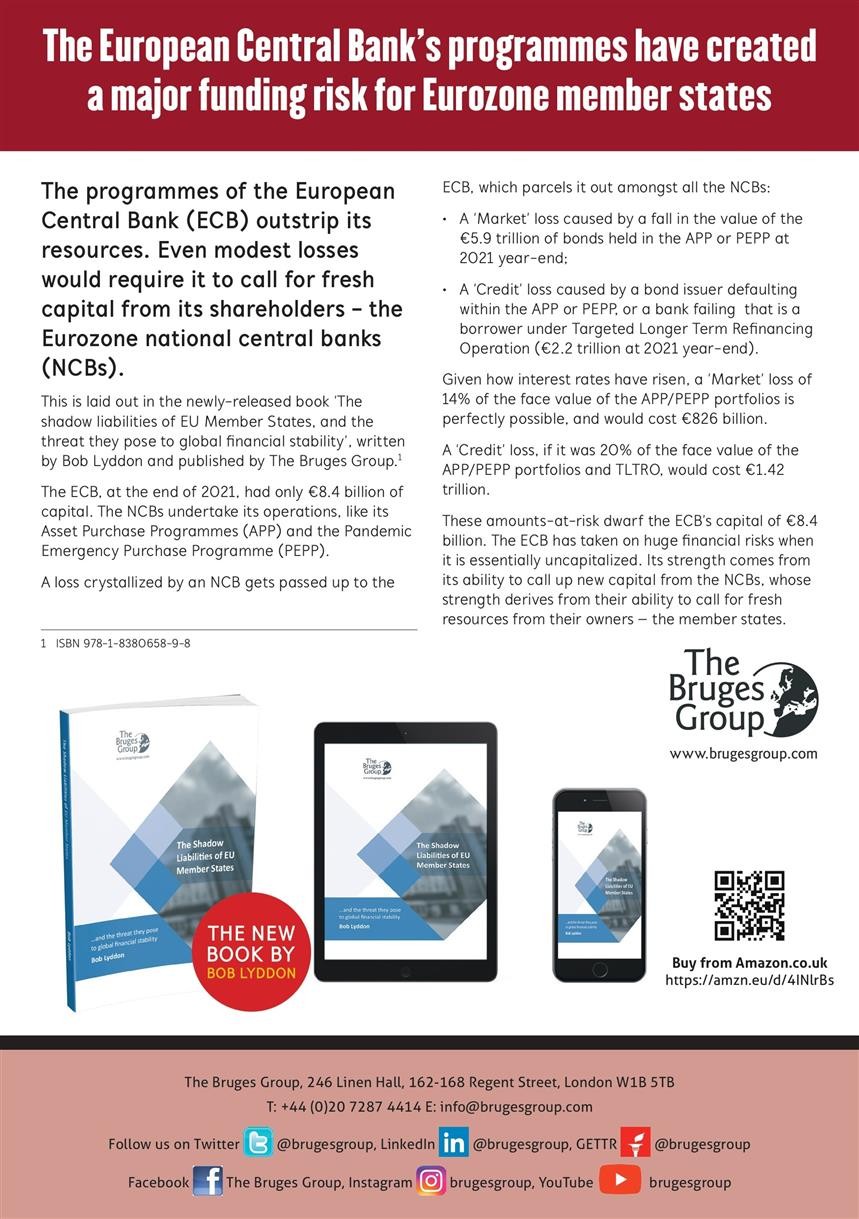Bruges Group Blog
The European Central Bank's programmes have created a major funding risk for Eurozone member states
The programmes of the European Central Bank (ECB) are extensive, and involve greater risks than the ECB can bear, it being very thinly capitalised. Even modest losses on its programmes would require it to be recapitalised by its Eurozone shareholders – the national central banks (NCBs) of the Eurozone member states.
This is laid out in the newly-released book 'The shadow liabilities of EU Member States, and the threat they pose to global financial stability', written by Bob Lyddon and published by The Bruges Group.
The ECB, at the end of 2021, had only €8.4 billion of capital and a correspondingly low capacity to trade. It is the NCBs that undertake its operations, like its Asset Purchase Programmes (APP), the Pandemic Emergency Programme (PEPP), and Targeted Longer-Term Refinancing Operations (TLTRO). The amounts involved in those programmes dwarf the ECB's balance sheet.
If a loss occurs at the NCB level, the NCB that incurred it passes it back to the ECB. The ECB then splits the loss amongst all the NCBs – including the one that incurred it – by debiting a portion of the loss to the capital account of each NCB in accordance with its ECB Capital Key. The loss diminishes the ECB's capital, requiring a recapitalisation at some stage and a pay-in by the NCBs of each one's share of the amount, again according to each one's ECB Capital Key.
The loss can come about in two main ways:
1. A 'Market' loss caused by a decline in the value of the €5.9 trillion of bonds held in the APP or PEPP at the end of 2021;
2. A 'Credit' loss caused by the default of the counterparty to an asset in an ECB programme, whether that is a bond issuer defaulting within the APP or PEPP, or a bank going into resolution that is a borrower under TLTRO (€2.2 trillion at the end of 2021).
Using reasonable estimates such as bonds having an average remaining life of 7 years and interest rates rising by 2%, the 'Market' loss – and consequent need for the capitalisation of the ECB – would be about 14% of €5.9 trillion, or €826 billion. The 'Market' loss would be realised if the ECB decided to sell bonds out prior to their maturity – as they are doing under 'Quantitative Tightening' – and if interest rates had risen since the bonds were purchased – as they have done.
All of the bond portfolio and TLTRO involve 'Credit' risk, and their combined amount was €7.1 trillion at the end of 2021. Borrowing from a commercial bank's 'Internal Ratings-Based Methodology', we can put the 'Credit' risk at 20% of this €7.1 trillion, or €1.42 trillion.
The ECB has taken on huge financial risks when it is essentially uncapitalised. Its strength comes from its ability to call up new capital from the Eurozone national central banks, who are uncapitalized and whose strength derives from their ability to call for fresh resources from their owners – the member states. The ECB has created a huge exposure for the Eurozone member states: €826 billion of 'Market' risk and €1.42 trillion of 'Credit' risk, or €2.25 trillion in all.
When you subscribe to the blog, we will send you an e-mail when there are new updates on the site so you wouldn't miss them.
Contact us
246 Linen Hall, 162-168 Regent Street
London W1B 5TB
Director : Robert Oulds MA, FRSA
Founder Chairman : Lord Harris of High Cross





